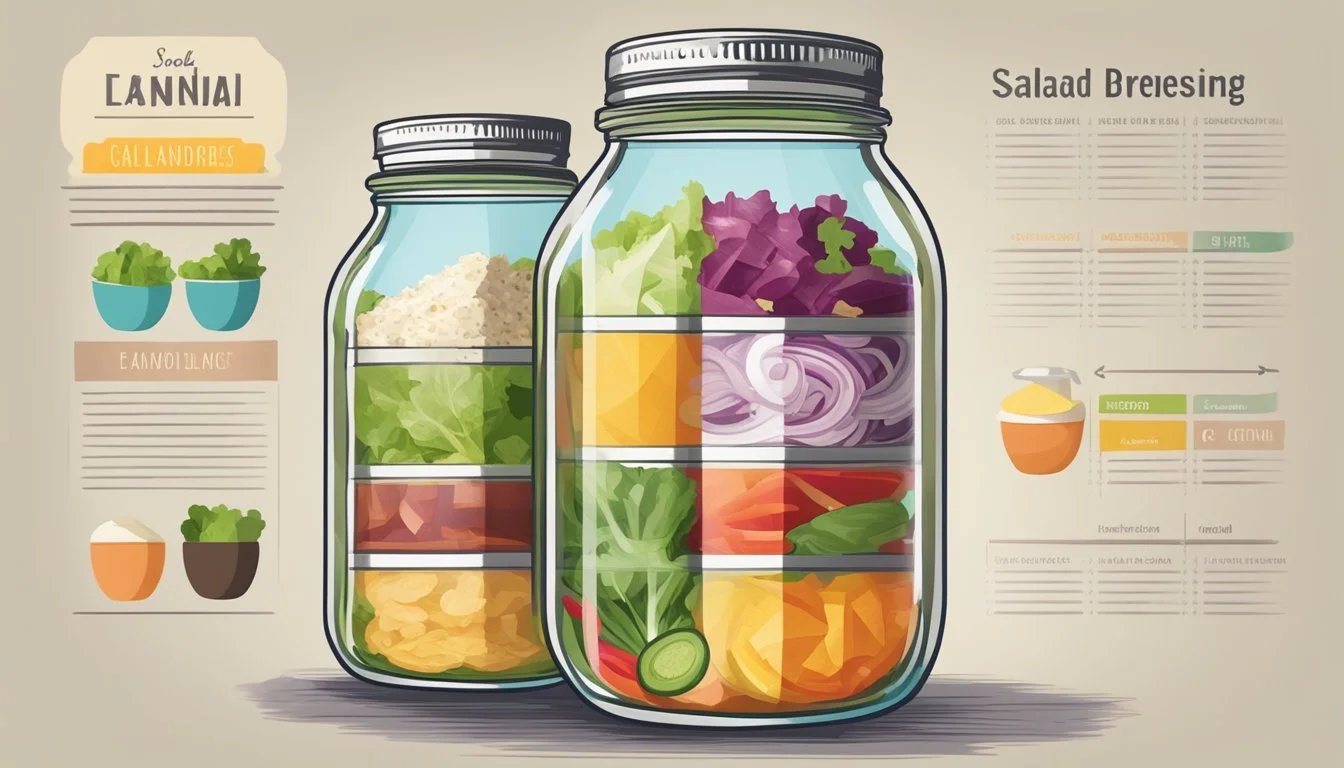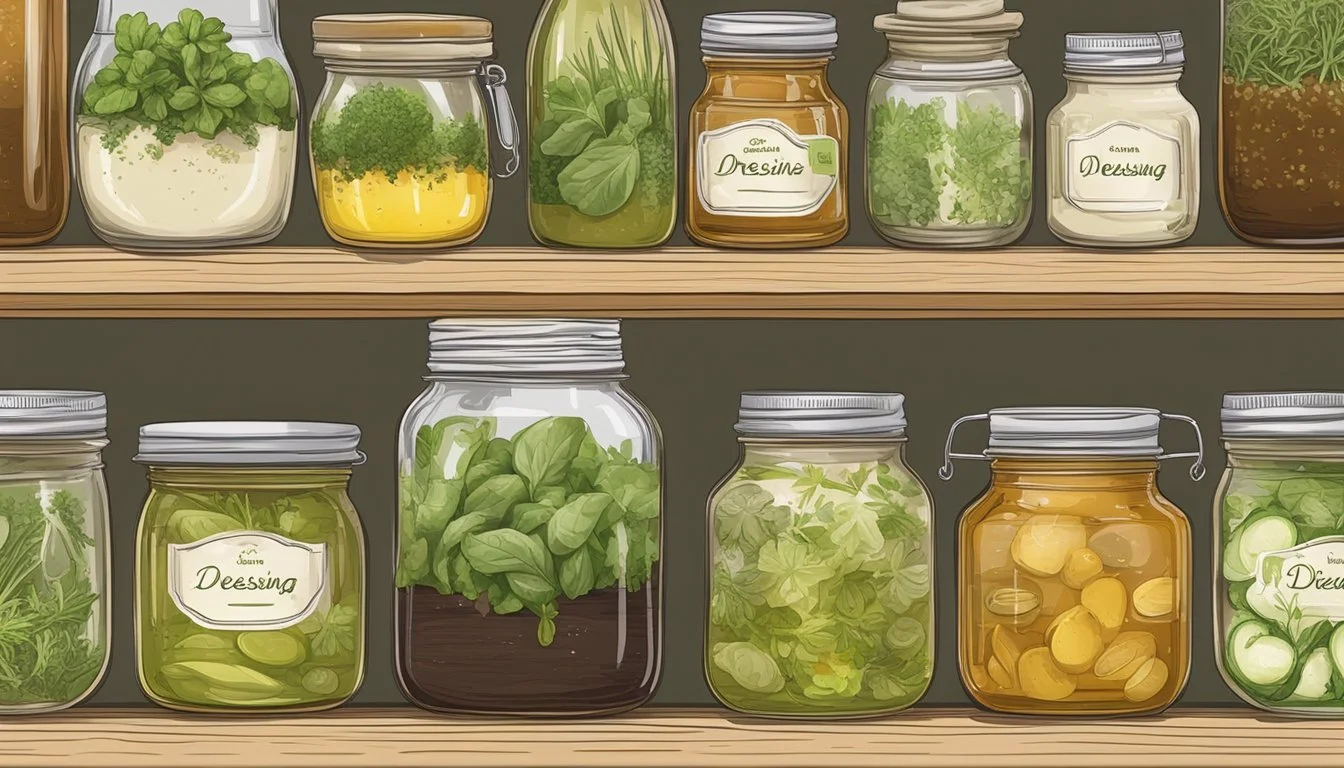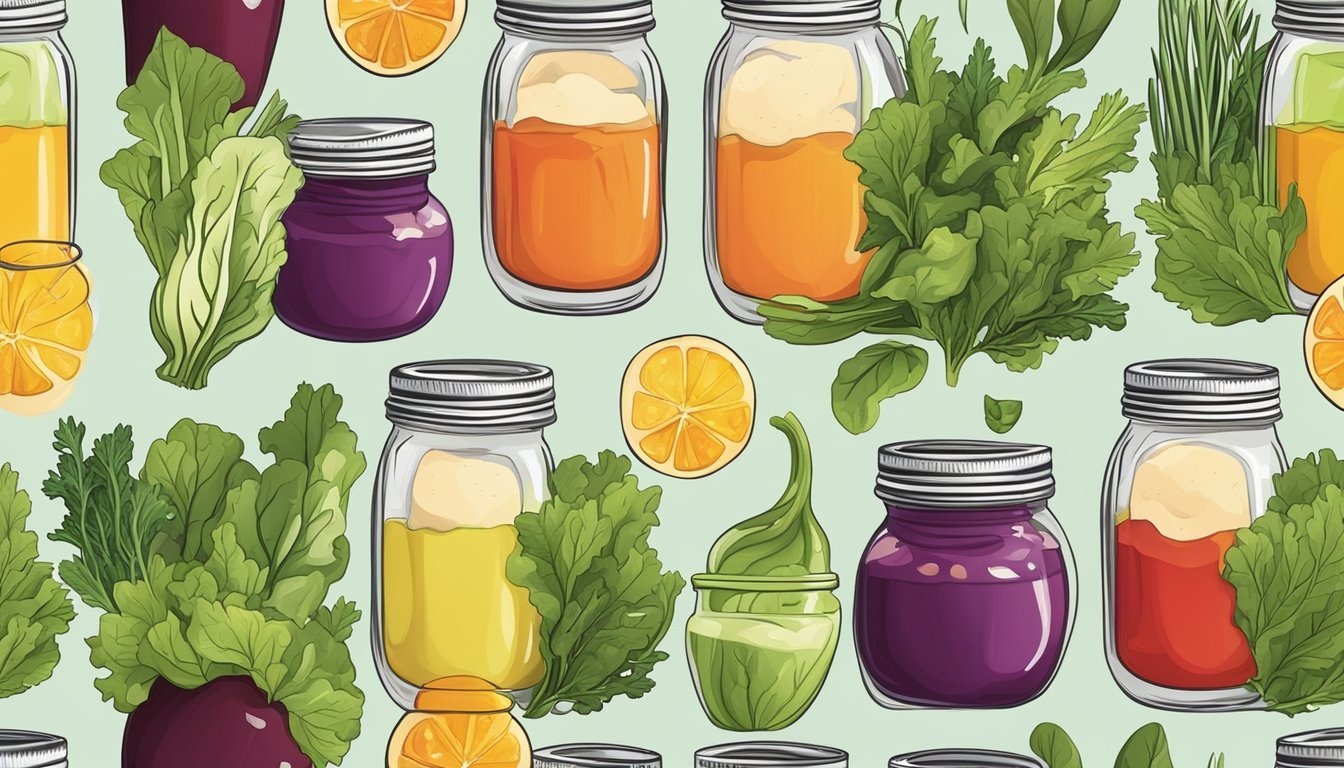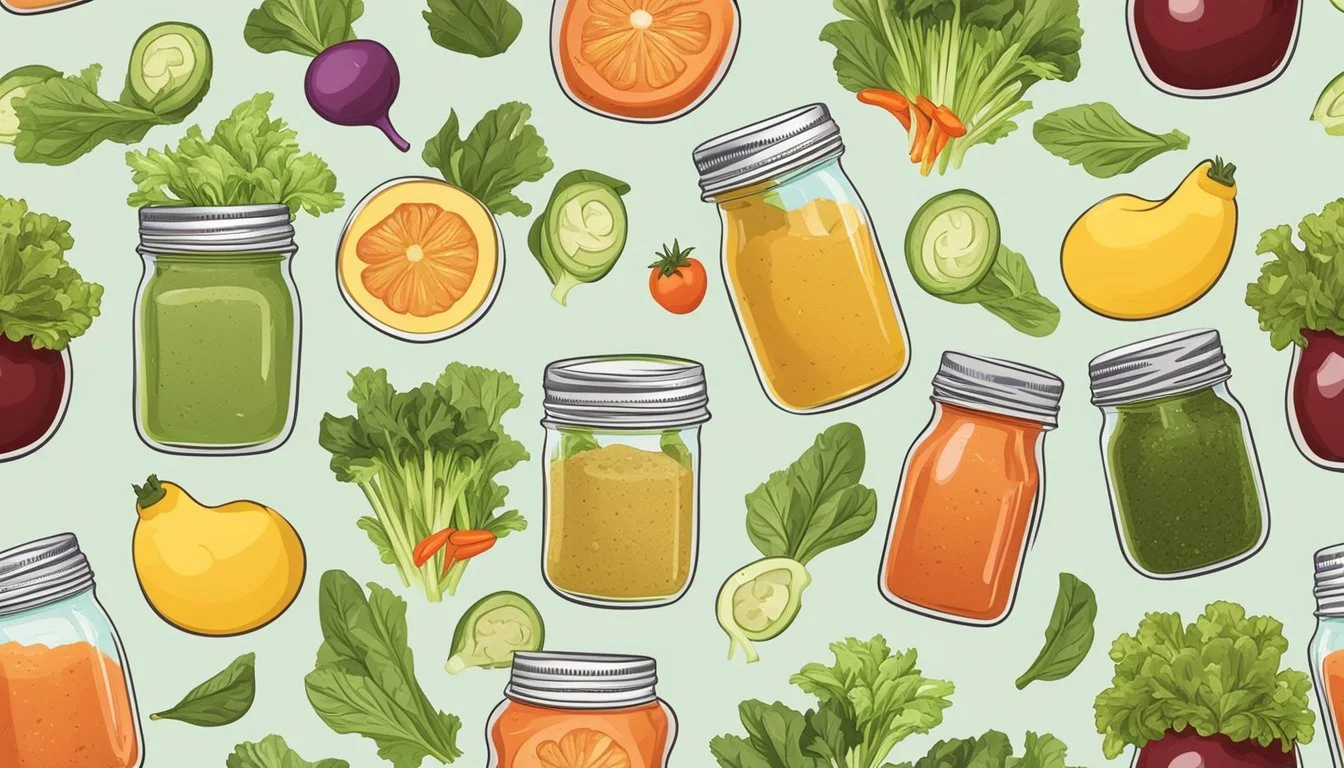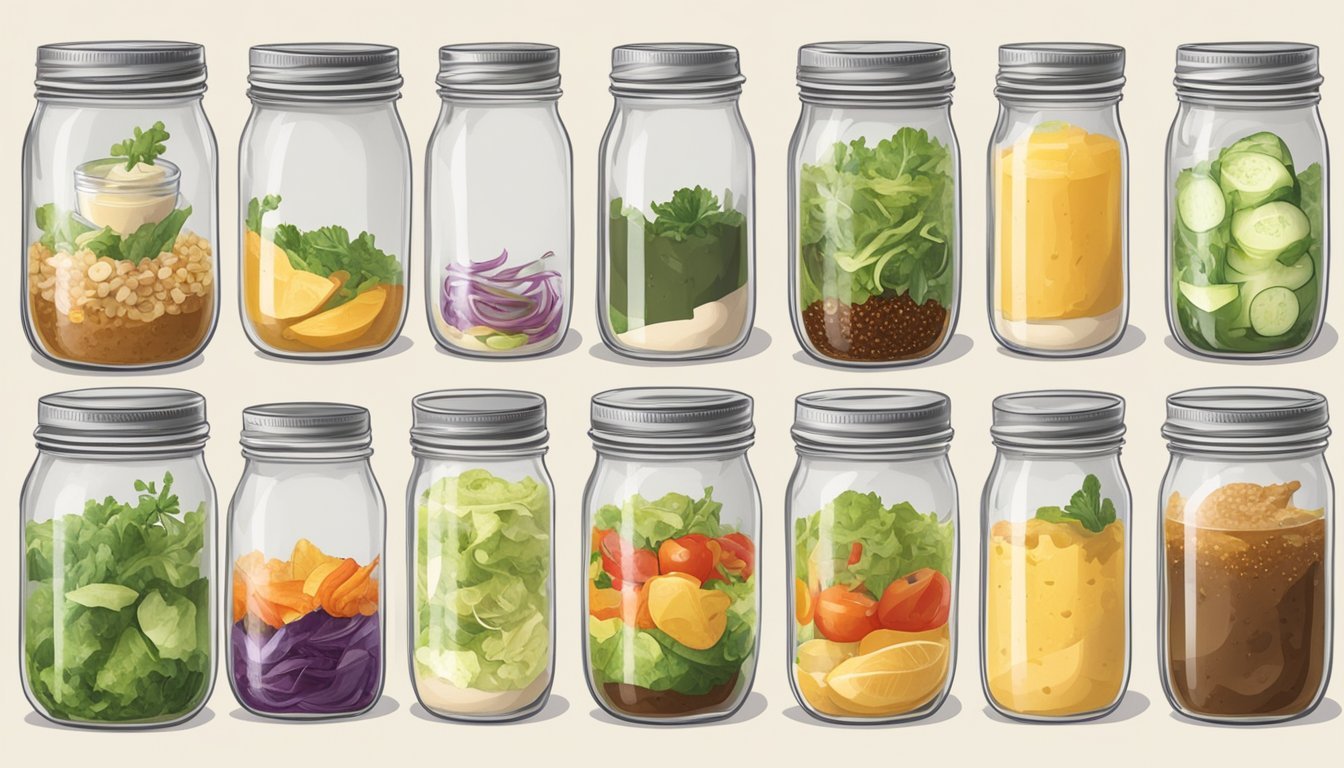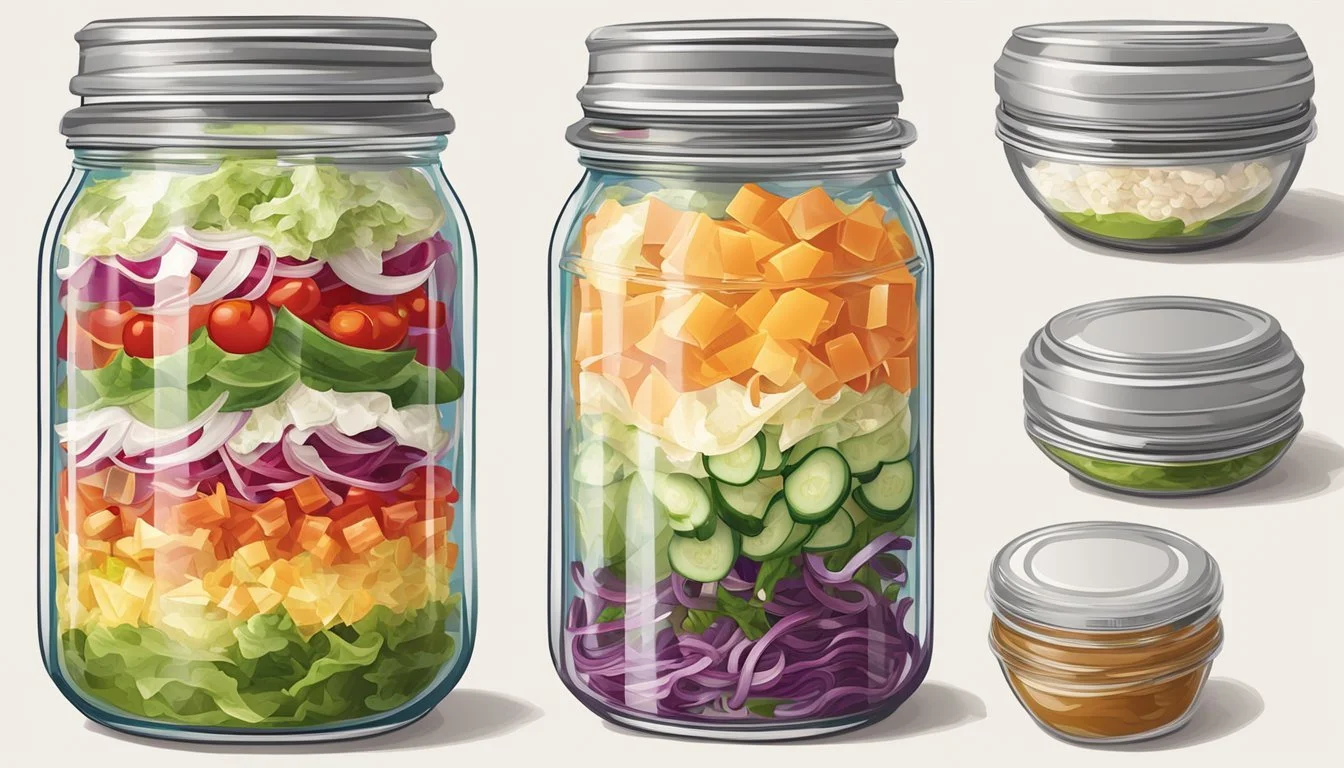The Mason Jar Salad Dressing
Simple Techniques to Intensify Your Greens
The Mason jar has emerged as a kitchen staple, not just for its rustic charm but for its versatility in meal preparation and storage. Its airtight seal makes it the perfect vessel for shaking up salad dressings without the need for a blender or extra utensils. With minimal effort, this method allows anyone to blend their favorite oils, vinegars, and seasonings into perfectly emulsified dressings that enhance any salad.
Mason jar salad dressings offer convenience and customization. Home cooks can rely on their creativity or follow simple recipes to concoct unique flavors. Whether it's a tangy balsamic vinaigrette, a creamy herb-infused ranch, or a zesty citrus ponzu dressing, the process remains as straightforward as combining ingredients in the jar and giving it a vigorous shake. This shake-and-store approach not only streamlines the salad-making process but also encourages healthier eating by forgoing preservatives and additives often found in store-bought dressings.
Moreover, preparing salad dressings in a Mason jar reduces kitchen clutter and simplifies clean-up. By measuring, mixing, and storing all in the same jar, there's minimal waste and mess. The sealable top also means these dressings can be prepared in advance and stored in the refrigerator for several days, making it a time-saver for meal prepping. With the right ingredients and a little shaking, dressings from a Mason jar can become an integral part of the culinary routine, offering both freshness and flavor with each salad served.
The Basics of Mason Jar Salad Dressing
Creating homemade salad dressings in a mason jar is a simple and efficient method to add fresh, customized flavors to any salad. The process involves combining all the necessary ingredients in a single mason jar and shaking them until emulsified—no blender required.
Ingredients & Ratios: A basic vinaigrette can start with a classic ratio of three parts oil to one part acid, such as vinegar or lemon juice. From there, additions like mustard, honey, or herbs can be added for complexity. Here's a foundational template:
Oil: 3 parts (e.g., olive oil)
Acid: 1 part (e.g., apple cider vinegar)
Sweetener: to taste (e.g., honey)
Seasonings: to taste (e.g., salt, pepper, garlic powder)
Method:
Measure and pour the oil and acid directly into the mason jar using its measurement markings.
Add the sweetener, mustard, or any other flavorings.
Secure the lid tightly.
Shake vigorously until ingredients are well combined.
Freshness & Storage: Mason jar salad dressings have the advantage of being made fresh, which allows for better control over the quality and taste. Moreover, dressings can be prepared in advance and stored in the refrigerator within the same jar for convenience.
By adhering to these basics, one can customize a range of mason jar salad dressings to complement any salad, ensuring a fresh, homemade touch with minimal effort.
Ingredients for Flavor and Health
Creating a mason jar salad dressing is about balancing health with a burst of flavor. This section delves into the specific ingredients one can use to add zest to salads (What wine goes well with salads?) while keeping an eye on nutrition.
Oils and Fats
The foundation of most dressings, oils provide richness and mouthfeel. Extra virgin olive oil is a top choice for its flavor and health benefits; it's high in monounsaturated fats, which are good for heart health. For those tracking calories, it's important to measure oil portions, as it is calorie-dense.
Vinegars and Acidity
Vinegars and acids turn a flat dressing into a vibrant one. Lemon juice adds a fresh, citrusy spark, while apple cider vinegar offers tangy notes and digestive benefits. Balsamic stands out for its complexity and hint of sweetness. The acidity in these ingredients also aids in balancing out the oil's richness.
Balsamic Vinegar: Rich, slightly sweet, perfect for Italian-style dressings.
Apple Cider Vinegar: Tangy, with potential health benefits.
Lemon Juice: Bright and citrusy, excellent with fish or chicken.
Seasonings and Sweeteners
Balancing flavors often calls for a touch of sweetness alongside seasonings. Honey and maple syrup are natural sweeteners that bring out the flavors of the dressing without adding refined sugars. Seasoning with kosher salt and freshly ground pepper is essential for enhancing all other flavors.
Honey Mustard Dressing: Combines sweetness and tang.
Kosher Salt: A pure, larger-grained salt for even seasoning.
Cracked Pepper: For a fresh bite and aroma.
Add-ins for Texture and Taste
For those wanting to elevate their dressing, mustard works as a great emulsifier and flavor enhancer—Dijon mustard being a favorite for its mild spice. Minced fresh garlic adds a punchy flavor and depth to the vinaigrette, and both are integral in creating a moreish quality that will make salads more appealing.
Dijon Mustard: A creamy emulsifier with a smooth, sharp taste.
Fresh Garlic: Adds depth and a healthful zing.
Classic Mason Jar Salad Dressing Recipes
Mason jar salad dressing recipes provide an easy and efficient way to mix and store dressings. Not only do they simplify the process, but they also allow for a quick shake to re-emulsify ingredients before dressing a salad.
Vinaigrette Mastery
Vinaigrettes are emulsions of oil and vinegar, often enhanced with various seasonings. A classic vinaigrette can be made by combining three parts oil with one part vinegar. Balsamic vinaigrette, for instance, involves balsamic vinegar, extra virgin olive oil, a touch of honey for sweetness, and Dijon mustard to stabilize and add a hint of spice.
Basic Balsamic Vinaigrette Recipe:
3 parts extra virgin olive oil
1 part balsamic vinegar
1 teaspoon honey
1 teaspoon Dijon mustard
Salt and pepper to taste
Creamy Dressing Creations
For those who favor creamier dressings, ingredients like Greek yogurt or blue cheese can be the base. A ranch dressing made in a mason jar might include a blend of Greek yogurt, mayonnaise, dried herbs, garlic powder, and buttermilk. Such dressings are perfect for those who prefer a more robust flavor and texture.
Greek Yogurt Ranch Dressing Recipe:
1/2 cup Greek yogurt
1/4 cup mayonnaise
1/4 cup buttermilk
1 tablespoon dried chives
1 teaspoon garlic powder
Salt and pepper to taste
Specialty Dressings and Variations
Specialty dressings often include unique or additional flavors that diverge from classic recipes. Components like soy sauce, ginger, or citrus juice can introduce new profiles. The versatile nature of a honey mustard dressing is ideal for including variations. By adjusting the ratio of honey to mustard, or by adding ingredients like orange zest or apple cider vinegar, one can tailor the dressing to their liking.
Honey Mustard Dressing Recipe:
1/2 cup Dijon mustard
1/2 cup honey
1/4 cup apple cider vinegar
2 tablespoons olive oil
Optional: Orange zest or a squeeze of fresh lemon juice
Emulsification Techniques Without a Blender
Creating an emulsified salad dressing without a blender is straightforward and can yield delicious results. Key techniques involve vigorous shaking or the inclusion of natural emulsifiers to stabilize the mixture.
The Shaking Method
For those without access to electrical appliances, the shaking method is an effective way to emulsify dressing ingredients. It involves adding all components into a mason jar, ensuring a tight seal of the lid. The ingredients are then shaken vigorously, which allows the oil and vinegar or lemon juice to blend into a smooth, homogenous mixture. The process requires:
A mason jar with a tight-fitting lid: This contains the ingredients and facilitates the shaking process.
Brisk shaking: It's essential to shake the mixture for at least a minute or two.
The shaking action creates a temporary emulsion, allowing the dressing's flavors to meld together.
Emulsifiers to Use
To ensure the dressing remains emulsified longer, one must incorporate natural emulsifiers. These substances have properties that combine water and oil, which usually do not mix well. Some common emulsifiers include:
Mustard: Particularly Dijon mustard, which is effective in small quantities.
Honey: Its natural stickiness aids in binding ingredients together.
Egg yolks: They contain lecithin, a compound that stabilizes emulsions.
These emulsifiers should be added to the mason jar before shaking to help maintain the stability of the dressing. Emulsified dressings not only have improved texture but also enhanced flavor distribution throughout the salad.
Storing Your Mason Jar Salad Dressing
Proper storage of mason jar salad dressing extends its freshness and maintains flavor quality. They should know the ideal refrigerator settings and expected shelf life of their homemade dressings.
Refrigeration Best Practices
When storing mason jar salad dressings, maintain a consistent refrigerator temperature. The optimal range is between 35°F (1.7°C) to 38°F (3.3°C) to ensure that the dressing remains fresh. Utilizing airtight mason jars is crucial; it prevents the ingress of flavors from other foods in the fridge and potential contamination.
For those who meal prep, they can fill the bottom of their mason jars with the dressing and then layer other salad components on top, ensuring the delicate greens remain separate and crisp.
Shelf Life and Freshness
Home-made mason jar salad dressings usually have a shelf life of 1 to 2 weeks when stored correctly in the fridge. The freshness of ingredients before mixing, however, can impact this timeline. To gauge maximum freshness, one should always:
Smell the dressing before use for any off odors
Look for changes in texture or separation that doesn't resolve with shaking
For best results, one should prepare their dressings using fresh, high-quality ingredients and consume them within the first week of preparation. Regularly checking the salad dressing ensures the quality of one's meal is up to standard.
Nutritional Information and Dietary Considerations
When crafting mason jar salad dressings, understanding the nutritional components and how to adjust for dietary needs is crucial. This section will explore the macronutrient content of typical dressing ingredients and suggest modifications for common dietary restrictions.
Understanding Macronutrients
Carbohydrates: Typical ingredients like honey or maple syrup add sweetness and can increase the carbohydrate content of the dressing. For example, one tablespoon of honey contains about 17 grams of carbohydrates.
Protein: Salad dressings generally contribute minimal protein; however, incorporating ingredients such as Greek yogurt can boost protein content.
Fat: Olive oil is often used as the base for many dressings, providing healthy monounsaturated fats. Concerning fat content, one tablespoon of olive oil contains about 14 grams of fat, which includes 2 grams of saturated fat.
Sodium: Depending on the recipe, sodium levels can vary. Ingredients like soy sauce or pre-made seasonings can be high in sodium. One tablespoon of soy sauce, for example, can contain upwards of 900 milligrams of sodium.
Fiber: While most salad dressings are not significant sources of fiber, adding ingredients like pureed fruits or vegetables can impart additional fiber.
Calories: Dressings can vary greatly in their caloric density, largely influenced by the oil and sugar content. Every tablespoon of olive oil adds approximately 120 calories.
Potassium: Some dressing ingredients may contribute to the potassium content, such as lemon juice or creams, but this is generally minimal.
Dietary Restrictions and Adjustments
For individuals with specific dietary needs, adjustments may be necessary:
Reduced Sugar: To lower sugar content, sweeteners such as honey or maple syrup can be minimized or substituted with low-calorie sweeteners.
Low-Fat Alternatives: To reduce saturated fat, olive oil can be replaced with other lower-fat oils or fat-free ingredients like broth or vinegar.
Low-Sodium Options: For those monitoring sodium intake, ingredients like salt and soy sauce can be reduced or replaced with low-sodium variants.
Allergy Conscious: For food allergies, ensure all ingredients are free of the allergen. For example, for gluten sensitivities, use tamari or a gluten-free soy sauce.
In conclusion, by understanding the nutritional aspects and potential dietary adjustments of mason jar salad dressings, individuals can make informed choices that meet their personal health requirements.
Pairing Dressings with Salads
The right dressing can elevate a salad from ordinary to exceptional by perfectly balancing flavors and complementing the ingredients. Specifically, the focus is on matching the dressing's flavor profile with the salad components to ensure coherence in taste.
Matching Dressings to Salad Types
When selecting a dressing for a salad, it's important to consider the type of salad and its ingredients. Here are some pairings that highlight this approach:
Winter Salads: Winter salads often feature hearty greens and root vegetables. A dressing with a robust flavor, such as a garlicky Caesar or a balsamic Dijon, complements these sturdy ingredients.
Pasta Salad: Pasta salads pair well with Italian or Greek dressings that offer a balance of herbs and acidity to cut through the starchy base.
Spinach Salad: Spinach's (What wine goes well with spinach?) mild flavor is enhanced by dressings with a hint of sweetness, like honey mustard or a raspberry vinaigrette.
Salads with Tomatoes: Tomatoes benefit from dressings that highlight their natural acidity and sweetness, such as a classic Italian or a garlic sesame dressing.
Fruit-Incorporated Salads: Fruity salads need dressings that don't overpower the delicate sweetness of fruits. A citrus vinaigrette or a poppy seed dressing would be apt choices.
Balancing Flavors and Ingredients
A well-crafted dressing achieves a balance of flavor profiles - sweet, sour, salty, and umami - and complements the salad's ingredients:
Acidity: Brightens and lifts the overall flavors. For instance, a lemon vinaigrette can cut through the fattiness of avocado or cheese.
Sweetness: Counteracts bitterness and adds depth. A bit of honey in a dressing pairs beautifully with bitter greens like kale.
Balance: Consider a dressing that will marry all the ingredients together. For example, salads that contain fruits will benefit from a slight acidity and sweetness in the dressing to enhance the fruit's natural flavors without overwhelming them.
By carefully choosing a dressing that aligns with the components of your salad, you can ensure that each bite is harmonious and flavorful.
DIY Mason Jar Dressing as Gifts
Creating DIY mason jar dressing gifts offers a unique and personal touch for any occasion. They provide a clever way to share homemade goodness with friends and family.
Decorating and Labeling
Successful gifting starts with presentation. For mason jar dressings, consider the following decor and labeling tips:
Wrap the jar with twine or ribbon for a rustic look.
Use fabric cutouts under the screw band for added charm.
Attach labels to the jars with the dressing name. Consider waterproof labels for longevity.
Decorate the labels with hand drawings or stamps for a personal touch.
Recipe Cards and Serving Suggestions
To complement the mason jar, include a recipe card:
On one side, print or write the dressing recipe.
On the reverse, suggest salads or dishes that pair well with the dressing.
If gifting multiple dressings, consider a booklet of cards tied with ribbon.
Laminate the cards to protect them from kitchen spills.
Remember, a mason jar dressing gift is not just about the taste; it’s also an expression of creativity and care.
Navigating Food Safety
When making Mason jar salad dressings, ensuring food safety is paramount. Attention to potential contamination risks and adherence to cleanliness can prevent foodborne illness.
Contamination Risks
Contamination in Mason jar salad dressings can arise from several sources. It is crucial to recognize these risks to ensure the safety of the dressing.
Ingredients: Use fresh, unexpired ingredients to avoid bacterial growth.
Utensils and jars: Ensure that all utensils, jars, and lids are sterilized before use to kill any harmful microbes.
Best Practices for Cleanliness
Maintaining cleanliness is essential during the preparation and storing of Mason jar salad dressings. Here are specific best practices to follow:
Washing Hands: Always wash hands thoroughly with soap and water for at least 20 seconds before preparing the dressing.
Cleaning Work Surfaces: Disinfect countertops and work surfaces both before and after preparing the dressing.
Sterilization: Mason jars should be sterilized by boiling them in water for 10 minutes or using a dishwasher with a sterilize cycle.
Proper Storage: Store dressings in the refrigerator and observe the recommended shelf life for homemade dressings, which is typically up to one week.
The Role of Salad Dressing in Nutrition
Salad dressings play a significant role in enhancing the nutritional value and appeal of salads. They can contribute both health benefits and influence weight management, depending on their components.
Health Benefits
Salad dressings, when prepared with the right ingredients, can boost nutritional intake. Ingredients like extra virgin olive oil provide healthy fats that increase the absorption of fat-soluble vitamins A, D, E, and K from vegetables. Lemon juice, a common addition, is rich in vitamin C, which can aid in iron absorption. Homemade dressings allow for the inclusion of nutrient-dense components like honey, mustard, and vinegar, without unwanted additives found in some store-bought dressings. By knowing the ingredients, one can ensure they are capitalizing on the potential health benefits:
Extra virgin olive oil: A source of monounsaturated fats.
Lemon juice: Enhances iron absorption.
Vinegar: May help regulate blood sugar levels.
Herbs and spices: Can contribute additional nutrients and antioxidants.
Portion Control and Weight Management
Utilizing mason jars for dressing preparation aids in portion control, a key factor in weight management. Knowing the specific measurements going into the jar, individuals can better manage their calorie intake. Below is an example of how portion sizes can be controlled with a mason jar:
Ingredient Portion Size Olive oil 1 cup Vinegar 1/2 cup Lemon juice Juice of 1 lemon Honey 1/2 tbsp Mustard 1/2 tbsp Coconut aminos or soy 1 tbsp
This approach promotes a mindful consumption of calories, with the transparency to adjust ingredients such as oils and sweeteners that are higher in calories. Mason jar dressings, shaken before use, encourage uniform distribution of flavors without the need for excessive quantities.
Economic Benefits of Homemade Dressings
Preparing homemade salad dressings in mason jars can be both cost-effective and a practical way to manage a food budget. This hands-on approach allows for significant savings when compared to purchasing premade dressings from a store.
Cost Comparison with Store-Bought
Ingredient expenses: The cost of store-bought dressings often includes a markup for branding, packaging, and distribution. In contrast, the ingredients for homemade dressings can be purchased in bulk and used to create multiple batches, reducing the cost per serving.
Ingredient Homemade Cost Store-Bought Cost Olive oil $0.10/oz $0.40/oz Vinegar $0.05/oz $0.18/oz Mustard $0.03/oz $0.12/oz Spices & Herbs $0.10/oz $0.50/oz
*Costs are estimated and may vary.
Packaging savings: Mason jars are reusable, eliminating the need for buying new bottles each time dressing is needed.
Managing a Salad Dressing Budget
Control over quantities: Homemade dressing makers can adjust the amount they make to avoid waste, whereas store-bought dressings may go unused and expire.
Versatility: A single base of oil and vinegar can be transformed into a variety of dressings with minor adjustments, making it unnecessary to buy multiple different types of dressings.
By understanding these economic benefits, consumers can make more informed decisions that align with their financial goals and dietary preferences. Homemade salad dressings offer an alternative that can lead to a more mindful and frugal lifestyle.
Accessorizing Your Salad Dressing
Crafting the perfect salad dressing in a mason jar isn't just about mixing ingredients; it’s about enhancing the user experience with the right accessories. Selecting the appropriate equipment can make the preparation process simpler and extend the utility of mason jars beyond dressing creation.
Additional Equipment
To elevate the dressing-making process, one might consider a few additional tools. Measurement markings on mason jars can guide users in adding precise amounts of oil, vinegar, and other dressing components. However, for ingredients that need finer measurements, like honey or mustard, miniature measuring spoons are beneficial. The enclosed table lists essential equipment that assists in dressing preparation:
Equipment Purpose Reusable lids For sealing and storing the dressings Mini whisk To emulsify ingredients before shaking Pour spout lids To control the dressing flow when serving Labeling material For marking contents and date of preparation
Using Mason Jars Beyond Dressing
Mason jars serve multiple functions in the kitchen, beyond holding homemade salad dressings. Their airtight sealing capability ensures that dressings retain freshness when stored in the refrigerator. Furthermore, they can be repurposed for storing layered salads—with the dressing at the bottom—allowing for a fresh mix when shaken just before consumption. For those interested in sustainable practices, mason jars provide an eco-friendly alternative to single-use plastic containers when bringing salads and dressings to work or on picnics.
Conclusion
Mason jar salad dressings have proven to be an efficient, eco-friendly, and versatile approach to enhancing salads. The method is simple: measure, add, shake, and it's ready to serve. The glass containers not only allow for the easy combination of ingredients but also provide a visual appeal and assure the absence of unwanted chemicals sometimes found in plastics.
Salad enthusiasts can appreciate the diversity in dressing options, ranging from the zest of a chipotle lime dressing to the freshness of an herb ranch. Moreover, with each shake, the vinaigrettes emulsify into smooth, well-blended concoctions that evenly coat every leaf and ingredient in the salad.
With a mason jar, the storage of leftover dressing becomes straightforward and convenient. The airtight seal preserves the freshness, allowing homemade dressings to be enjoyed for several days. This method diminishes food waste and supports a more sustainable lifestyle.
In an era where home cooking is synonymous with health and economy, mason jar salad dressings stand out as a practical technique for any kitchen, regardless of cooking skill level. They encourage culinary creativity, healthy eating, and can lead to a more mindful and waste-conscious approach to food preparation.

